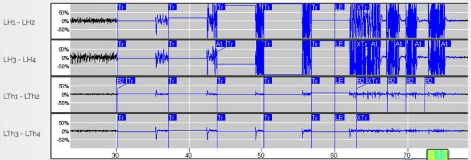Dual Target Amygdalohippocampal-Thalamic Low Frequency Responsive Neurostimulation Is More Effective Than Amygdalohippocampal High Frequency Responsive Stimulation in Temporal Lobe Epilepsy
Abstract number :
3.145
Submission category :
3. Neurophysiology / 3E. Brain Stimulation
Year :
2018
Submission ID :
502759
Source :
www.aesnet.org
Presentation date :
12/3/2018 1:55:12 PM
Published date :
Nov 5, 2018, 18:00 PM
Authors :
Abdulrahman Alwaki, Emory University; Katie Bullinger, Emory University; Rebecca E. Fasano, Emory University School of Medicine; Andres Rodrigues-Ruiz, Emory University; Ioannis Karakis, Emory University School of Medicine; Luke Edwards, Neuropace, Inc; a
Rationale: 1- Evaluate the efficacy of unilateral dual amygdalohippocampal-thalamic stimulation in temporal lobe epilepsy. 2- Compare the effect of low frequency responsive neurostimulation to standard amygdalohippocampal high frequency responsive stimulation in two cases of temporal lobe epilepsy. Methods: Two patients with intractable temporal lobe epilepsy were implanted with hippocampal and thalamic electrodes. We targeted unilateral anterior nucleus of the thalamus (ANT) in addition to implantation of leads in unilateral amygdala and hippocampus in each case.Preimplantation clinical data were collected. ECOG data was reviewed and parameters were adjusted based on seizure frequency. We compared the effect of standard high frequency 200 Hz stimulation with 100 ms burst duration to combined hippocampal-thalamic low frequency stimulation at 5 Hz with 5 second burst duration. Seizure outcomes after 18 month follow up were reported. Results: Patient 1: A 55-year-old right handed man with medically resistant focal epilepsy. He underwent right anterior temporal lobectomy in 1996 and VNS implantation in 2008 but continued to have weekly focal seizures with impaired awareness and occasional secondarily generalized seizures. The patient underwent SEEG evaluation that captured left hippocampal onset seizures. RNS was implanted using left hippocampal depth electrodes and left thalamus depth electrodes in 2015. He received the standard 200 Hz stimulation with 100 millisecond burst duration but continued to experience frequent seizures the first 12-18 months following RNS implantation. Low frequency lead to lead stimulation was programmed for his left Hippocampal and left Thalamic leads at 4.0 mA or 2.0uC/cm2 with 5 Hz stimulation rate and 5 second stimulation duration. The patient had 72% reduction in his seizure frequency from his baseline at 18 months follow up visit. Patient 2: A 37-year-old, right-handed woman with a history of seizures since age 3 years. She underwent left anterior temporal lobectomy that was associated with significant post-operative memory decline and received a VNS in 2001. Her follow up scalp video EEG evaluation recorded right temporal seizures. Her brain MRI showed right hippocampal atrophy with increased T2 FLAIR signal in addition to post surgical changes related to previous left ATL. Her PET scan showed right medial temporal hypometabolism. RNS was implanted in March-2016 using right hippocampal and right thalamic depth electrodes. Similar to patient 1, she initially received two bursts of standard high frequency stimulation but continued to have frequent seizures. She now has 2 bursts of stimulation turned on. The first burst stimulates the hippocampus for 100 milliseconds of 200 Hz stimulation at 2.5 uC/cm2 charge density. The second burst with the lead to lead stimulation at 1.3uC/cm2 for 5 seconds at 5Hz. The patient had 88% reduction in his seizure frequency from her baseline at 18 months follow up visit. Conclusions: These cases suggest that dual amygdalohippocampal-thalamic stimulation can improve the efficacy of responsive neurostimulaton in patients with medial temporal lobe epilepsy who are not candidate for destructive epilepsy surgery. We hypothesized that dual stimulation of the anterior nucleus of the thalamus and the amygdalohippocampal complex (ANT-AHC RNS) would provide better seizure control than AHC RNS alone. We further hypothesized that low frequency stimulation mimicking the thalamic-cortical hypersynchrony phase of natural seizure termination would be more effective than standard high frequency stimulation. Further studies are needed to evaluate the effect of different stimulation parameters on seizure control in this patient population. Funding: None

.tmb-.png?Culture=en&sfvrsn=95a94e31_0)